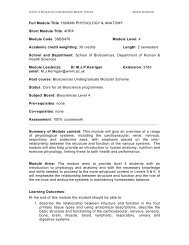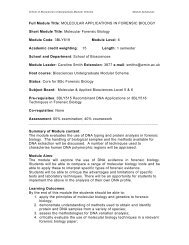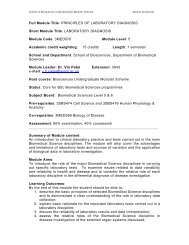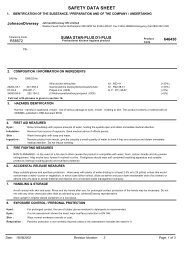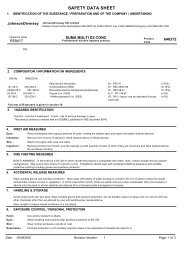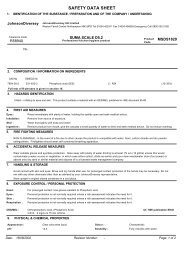CONTENTS 1. Introduction 1.1 Course Outline 1 1.2 Introduction ...
CONTENTS 1. Introduction 1.1 Course Outline 1 1.2 Introduction ...
CONTENTS 1. Introduction 1.1 Course Outline 1 1.2 Introduction ...
Create successful ePaper yourself
Turn your PDF publications into a flip-book with our unique Google optimized e-Paper software.
3. Learning Outcomes<br />
3.1 Year One<br />
The first year of the course aims to provide a thorough grounding in relevant science and<br />
mathematics, fundamental theories of photographic science, an introduction to experimental<br />
methods in the evaluation of images and imaging systems, practical skills in the use of a range of<br />
imaging systems and media, including photography and applied imaging applications, and<br />
transferable skills in communication, relevant computing and software, and study skills. The<br />
majority of modules in this year are core, ensuring that all students have a strong foundation in<br />
the fundamental knowledge and skills required to progress to the next level.<br />
Year One Learning Outcomes<br />
At the end of Year One, it is expected that students will be able to:<br />
Demonstrate Knowledge and Understanding in:<br />
• Photography and photographic practice (including digital techniques).<br />
• Image capture. Light Sources, filters and lighting. Exposure and the latent image. Camera<br />
Formats.<br />
• Fundamental theories of photographic science including the fundamental properties of both<br />
analogue and digital images and imaging systems<br />
• Scientific principles of human visual system, visual perception, principles of geometrical,<br />
physical and visual optics.<br />
• Simple wave and quantum properties of radiation and light.<br />
• Structure of Photographic materials. Spectral Sensitisation. Chemistry of the photographic<br />
process. Principles of the charge-coupled-device.<br />
• Relevant science and mathematics.<br />
• The principles of a range of techniques in applied imaging.<br />
• The significance of linear and non-linear systems in imaging chains.<br />
• The basic relationships between image properties and the physical processes producing the<br />
image.<br />
Cognitive and Intellectual Skills<br />
• Analyse the formation of images in compound optical systems.<br />
• Employ the basic methods of geometrical constructs and ray tracing in studying image<br />
formation in optical systems.<br />
• Relate aspects of image quality to measurable properties and measure simple aspects of<br />
objective image quality.<br />
• Employ a scientific approach to problems.<br />
• Understand the consequences of the relative performances of different systems and devices.<br />
• Select and critically evaluate images.<br />
Practical Skills<br />
• Acquire and process images using a wide variety of contemporary imaging systems.<br />
• Correctly expose and process a variety of different image formats.<br />
• Use a range of camera formats and equipment.<br />
• Print in black and white.<br />
• Demonstrate effective use and control of flash lighting.<br />
• Determine the optimum imaging systems to use for a specific application.<br />
• Measure and interpret the input-output relationships for a variety of imaging processes.<br />
• Apply acquired technical skills to creative ends.<br />
DPI_Hbook 11 ©University of Westminster





